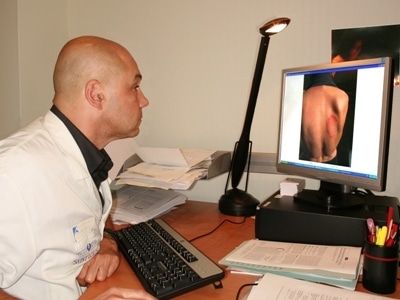THE treatment of complex dermatoses in a hospital environment requires an approach multidisciplinary and advanced strategies to respond to the challenges presented by these skin pathologies. The precise assessment of lesions and understanding the triggering factors are essential to make a correct diagnosis. Through the analysis of clinical cases, healthcare professionals can explore different therapeutic options, whether local care or systemic treatments. News integration therapeutic strategies allows a significant improvement in clinical results, thus promoting the well-being patients suffering from dermatoses complex.

Complex dermatoses represent a major challenge in dermatology, particularly in hospital settings where patients can present varied skin manifestations, often linked to other underlying pathologies. The analysis and management of these conditions requires a methodical approach, integrating advanced strategies to ensure accurate assessment and appropriate intervention.
The diagnostic approach in dermatology is based on the careful examination of skin lesions. The presence of these lesions provides the opportunity to perform direct clinical assessment, which is particularly relevant for complex dermatoses. During this examination, it is essential to pay attention to various characteristics of the lesions, such as their location, morphology and distribution. These clinical elements make it possible to guide the diagnosis and distinguish dermatoses of allergic, infectious or autoimmune origin.
In this context, therapeutic strategies must be adapted to the specific nature of each dermatosis. Atopic dermatitis, for example, requires a personalized approach including local care and, if necessary, systemic treatments. Emollients and topical corticosteroids are commonly used to reduce inflammation, while immunomodulatory agents may be considered if ineffective. Regular monitoring is essential to assess the effectiveness of treatments. If no improvement is noted after several months, a reassessment of the strategy must be carried out in order to optimize treatment.
The establishment of multidisciplinary consultation meetings (RCP) in dermatology also makes it possible to improve the treatment of complex cases. These meetings, which bring together dermatologists, allergists and other specialists, promote an exchange of expertise and guarantee an integrated approach. These discussions are particularly helpful for cases that do not respond to standard treatments or present diagnostic challenges. The interaction between different specialties can lead to therapeutic adjustments that are beneficial for patients.
Occupational dermatoses represent another category of complex conditions encountered in hospital settings. They are frequently linked to environmental exposures, such as humidity or handling chemicals. Contact dermatitis and irritant dermatitis are examples of conditions accentuated by these factors. Management often requires a modification of professional practices as well as patient education on the prevention of skin irritations.
Concerning clinical cases, each unique situation is of particular interest for the development of knowledge in dermatology. For example, a patient with pustular dermatitis may benefit from a thorough study of medical history, precipitating factors and previous treatments. The differential diagnosis could then include evaluation for systemic diseases, such as psoriasis, which would require targeted treatment. In this case, a combined therapeutic approach could be considered, integrating topical medications and systemic therapies.
Technological advances and new treatment modalities have also changed the situation in the management of complex dermatoses. Biological therapies, for example, have become valuable tools for treating more severe skin conditions. These treatments target particular immunological pathways and can produce significant results for conditions such as psoriasis or severe eczema. It is essential to closely monitor responses to treatment, as well as potential side effects, in order to adjust the therapeutic approach if necessary.
Clinical cases may also include patients with significant comorbidities, further complicating their management. A patient suffering from atopic dermatitis, for example, may also have an immune disorder that requires special attention. In these situations, interdisciplinary collaboration is crucial. Sometimes, interventions not only provide dermatological benefits, but also contribute to the improvement of the patient’s general health.
In order to optimize the management of complex dermatoses, it is fundamental to adopt an evidence-based approach. This involves consulting the most recent guidelines and participating in continuing education. Research also helps broaden therapeutic horizons, with clinical trials ranging from the evaluation of new drugs to population studies of risk factors and treatment outcomes.
Finally, patient education is a key element in the management of complex dermatoses. It is essential to inform patients about their condition, the treatment options available and the importance of regular follow-up. A participatory approach promotes adherence to treatment and increases the chances of significant improvement in symptoms. This also helps establish a relationship of trust, essential for successful treatment.

Introduction to complex dermatoses
The treatment of complex dermatoses in a hospital environment requires a methodical and personalized approach. Patients with these often resistant skin pathologies require advanced strategies and varied clinical cases to establish an accurate diagnosis and an effective treatment plan. This article discusses the different diagnostic and therapeutic techniques, as well as the importance of monitoring and adapting treatments according to the clinical evolution of patients.
Diagnostic approach in dermatology
There diagnostic approach in dermatology is based on the analysis of skin lesions, directly observable during clinical examination. Doctors must be able to assess signs, such as the morphology, distribution and evolution of lesions, in order to make a correct diagnosis. Medical history and environmental factors should also be considered, particularly for work-related or allergy-related dermatoses.
Therapeutic strategies for atopic dermatoses
Regarding the atopic dermatitis, the development of advanced therapeutic strategies is crucial. It is recommended to integrate local care such as emollients and the topical corticosteroids in the therapeutic protocol. If no positive results are observed after several months, a re-evaluation of the treatment is necessary. Physicians must remain attentive to clinical developments to adapt or interrupt therapies if necessary.
Clinical cases and interdisciplinary collaborations
THE clinical cases complex dermatology may require close collaboration between different specialists. For example, dermatologists may work with allergists to treat situations involving skin hypersensitivities. National meetings, such as those organized by the French Society of Dermatology, allow us to discuss complex cases and discuss best management practices.
Occupational dermatoses in hospitals
THE occupational dermatoses are common in hospital settings, often linked to factors such as humidity, handling of antiseptics or irritating chemicals. A careful assessment of working conditions is crucial to identify the causes of skin irritation and prevent its recurrence. Establishing prevention protocols, including personal protective equipment and appropriate training, is essential for medical personnel.
Monitoring and adaptation of treatment
Regular monitoring of patients with complex dermatoses is essential. It makes it possible to measure the effects of current treatments and adjust interventions according to the evolution of the lesions. Treatment must be adapted according to the intensity of the symptoms and acceptability by the patient. Thus, communication and patient education play a major role in the success of the therapies implemented.
Innovations in clinical dermatology
Technical and therapeutic advances continue to emerge in clinical dermatology. The use of systematic targeted treatments and innovative therapies could offer new alternatives to patients suffering from complex dermatoses. Research continues to explore new pharmacological pathways in order to optimize therapeutic results and reduce treatment-related side effects.












